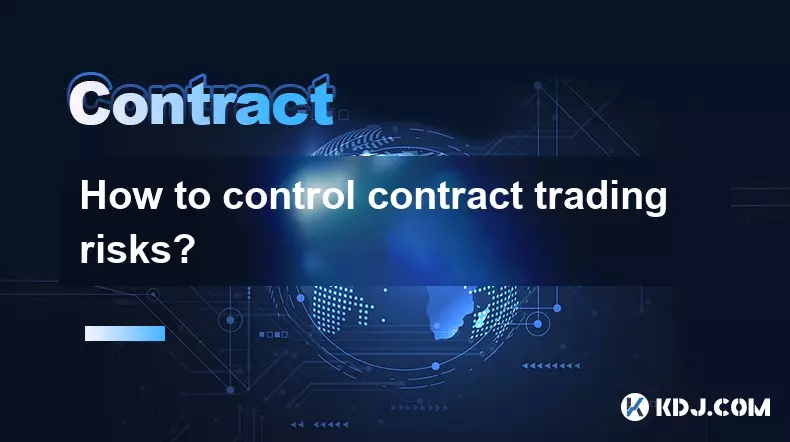-
 bitcoin
bitcoin $109667.069529 USD
-3.03% -
 ethereum
ethereum $3936.685804 USD
-4.07% -
 tether
tether $1.000493 USD
0.01% -
 xrp
xrp $2.771823 USD
-4.74% -
 bnb
bnb $957.805027 USD
-5.34% -
 solana
solana $196.735100 USD
-6.68% -
 usd-coin
usd-coin $0.999727 USD
-0.01% -
 dogecoin
dogecoin $0.227355 USD
-5.12% -
 tron
tron $0.335205 USD
-0.81% -
 cardano
cardano $0.779256 USD
-3.59% -
 ethena-usde
ethena-usde $0.999900 USD
-0.06% -
 hyperliquid
hyperliquid $42.492095 USD
-6.61% -
 chainlink
chainlink $20.501853 USD
-4.34% -
 avalanche
avalanche $28.952606 USD
-11.21% -
 stellar
stellar $0.356038 USD
-3.93%
How to control contract trading risks?
Effective risk management in contract trading involves stop-loss orders, proper position sizing, limited leverage, and emotional discipline to preserve capital.
Sep 20, 2025 at 01:00 pm

Risk Management Strategies in Contract Trading
1. Set stop-loss orders for every position to automatically close trades when losses reach a predetermined level. This prevents emotional decision-making during volatile market swings and ensures capital preservation.
2. Use position sizing wisely by allocating only a small percentage of total capital per trade. Many experienced traders risk no more than 1% to 2% of their portfolio on a single contract, minimizing the impact of losing trades.
3. Avoid over-leveraging even when high leverage is available. While leverage amplifies gains, it also magnifies losses. Staying below 5x or 10x leverage can significantly reduce liquidation risks during sharp price reversals.
4. Monitor open interest and funding rates to gauge market sentiment. Unusually high open interest combined with extreme funding rates may signal an overheated market prone to sudden corrections.
5. Diversify across different assets and avoid concentrating exposure on a single cryptocurrency. Correlations between digital assets can shift rapidly, and spreading risk helps maintain portfolio stability.
Technical Analysis for Safer Entries and Exits
1. Identify key support and resistance levels using historical price data. Entering long positions near strong support zones or shorting near resistance increases the probability of successful trades.
2. Utilize moving averages such as the 50-day and 200-day MA to determine trend direction. Trading in alignment with the dominant trend reduces the likelihood of being caught in counter-trend traps.
3. Apply momentum indicators like RSI and MACD to detect overbought or oversold conditions. These tools help avoid entering contracts when the market is due for a pullback.
4. Watch for chart patterns including triangles, flags, and head-and-shoulders formations. Recognizing these structures early allows traders to anticipate breakouts or reversals with better precision.
5. Combine multiple technical signals before executing a trade. A confluence of indicators—such as a breakout occurring at a Fibonacci extension level with rising volume—strengthens the validity of the setup.
Emotional Discipline and Trading Psychology
1. Stick to a pre-defined trading plan and avoid impulsive decisions based on FOMO or fear. Deviating from the strategy often leads to poor timing and increased drawdowns.
2. Keep a detailed trading journal that records entry and exit reasons, emotions felt, and outcomes. Reviewing past trades helps identify behavioral patterns and areas for improvement.
3. Take regular breaks from monitoring charts to prevent mental fatigue. Continuous screen time can cloud judgment and lead to reactive rather than strategic actions.
4. Accept that losses are part of the process. A string of losing trades does not invalidate a sound strategy if proper risk controls were followed.
Maintaining emotional control is just as critical as technical skill in avoiding catastrophic losses during high-pressure moments in contract trading.Monitoring Market Conditions and External Triggers
1. Stay updated on macroeconomic events such as interest rate decisions, inflation reports, and regulatory announcements. These factors heavily influence crypto market volatility and investor sentiment.
2. Track major on-chain metrics like exchange inflows, whale movements, and hash rate changes. Sudden shifts in on-chain activity can foreshadow large price moves.
3. Pay attention to social sentiment through platforms like Twitter, Telegram, and alternative data aggregators. Rapid spikes in bullish or bearish chatter may indicate potential market turning points.
4. Be cautious during scheduled events such as exchange listings, token unlocks, or protocol upgrades. These often trigger exaggerated price reactions that can trap leveraged positions.
5. Adjust trading activity during low-liquidity periods such as holidays or weekends. Reduced market depth increases slippage and makes exits harder during fast-moving scenarios.
Frequently Asked Questions
What is the most common mistake in contract trading?Over-leveraging is the most frequent error. Traders often take positions far beyond their risk tolerance, leading to rapid liquidations even with minor adverse price movements.
How can I protect my position from sudden liquidation?Place stop-loss orders at safe distances from current prices and maintain sufficient margin buffer. Avoid placing stops too close to volatile levels where whipsaws are common.
Why do experienced traders avoid holding contracts over weekends?Weekend markets typically have lower liquidity and higher spreads. Unexpected news or gaps upon market reopening can result in unfavorable fills or automatic liquidations.
Can automated bots help reduce contract trading risks?Yes, well-designed bots can enforce discipline by executing trades based on predefined rules. However, they require constant monitoring and adjustments to adapt to changing market dynamics.
Disclaimer:info@kdj.com
The information provided is not trading advice. kdj.com does not assume any responsibility for any investments made based on the information provided in this article. Cryptocurrencies are highly volatile and it is highly recommended that you invest with caution after thorough research!
If you believe that the content used on this website infringes your copyright, please contact us immediately (info@kdj.com) and we will delete it promptly.
- Bitwise, Hyperliquid ETF, and Perp DEXs: A New Era in Crypto Trading?
- 2025-09-26 12:25:15
- Ozak AI Price Prediction: Analyst Bull Case for $5 by 2026?
- 2025-09-26 12:25:15
- Bitcoin Price Wobbles: Support Failure and Trader Sentiment in the Mix
- 2025-09-26 12:45:16
- Dogecoin, Memecoins, and the Bull Cycle: Are We Still Barking Up the Right Tree?
- 2025-09-26 12:45:16
- Plasma Ignites DeFi: A New Dawn for Stablecoins and TVL?
- 2025-09-26 12:50:01
- Crypto Tax, Senate Showdown, and Trump Relief: What's the Deal?
- 2025-09-26 12:30:01
Related knowledge

How do I enable the "scalping-only" mode for Cardano (ADA) contracts?
Sep 24,2025 at 03:19am
Understanding Scalping Strategies in Crypto Derivatives1. Scalping in cryptocurrency trading refers to executing multiple short-term trades within min...

What is the maximum position limit for Cardano (ADA) contracts?
Sep 23,2025 at 11:00pm
Understanding ADA Futures and Derivatives Market Structure1. Cardano (ADA) futures contracts are offered by several major cryptocurrency derivatives e...

What is the maker fee for Cardano (ADA) contracts?
Sep 26,2025 at 09:01am
Understanding Maker Fees in Cardano (ADA) Contracts1. The concept of maker fees applies broadly across decentralized exchanges and smart contract plat...

How can I view open interest in Cardano (ADA) contracts?
Sep 24,2025 at 07:36am
Understanding Open Interest in Cardano Derivatives1. Open interest refers to the total number of outstanding derivative contracts, such as futures or ...

What is the function of the insurance fund in Cardano (ADA) contracts?
Sep 24,2025 at 02:18am
Understanding the Role of Insurance Funds in Cardano Smart Contracts1. The insurance fund within Cardano's ecosystem is not a native feature directly ...

How can I view historical transaction records for Cardano (ADA) contracts?
Sep 24,2025 at 04:01pm
Understanding Cardano's On-Chain Data Structure1. Cardano operates on a proof-of-stake blockchain that records all transactions in blocks secured thro...

How do I enable the "scalping-only" mode for Cardano (ADA) contracts?
Sep 24,2025 at 03:19am
Understanding Scalping Strategies in Crypto Derivatives1. Scalping in cryptocurrency trading refers to executing multiple short-term trades within min...

What is the maximum position limit for Cardano (ADA) contracts?
Sep 23,2025 at 11:00pm
Understanding ADA Futures and Derivatives Market Structure1. Cardano (ADA) futures contracts are offered by several major cryptocurrency derivatives e...

What is the maker fee for Cardano (ADA) contracts?
Sep 26,2025 at 09:01am
Understanding Maker Fees in Cardano (ADA) Contracts1. The concept of maker fees applies broadly across decentralized exchanges and smart contract plat...

How can I view open interest in Cardano (ADA) contracts?
Sep 24,2025 at 07:36am
Understanding Open Interest in Cardano Derivatives1. Open interest refers to the total number of outstanding derivative contracts, such as futures or ...

What is the function of the insurance fund in Cardano (ADA) contracts?
Sep 24,2025 at 02:18am
Understanding the Role of Insurance Funds in Cardano Smart Contracts1. The insurance fund within Cardano's ecosystem is not a native feature directly ...

How can I view historical transaction records for Cardano (ADA) contracts?
Sep 24,2025 at 04:01pm
Understanding Cardano's On-Chain Data Structure1. Cardano operates on a proof-of-stake blockchain that records all transactions in blocks secured thro...
See all articles










































































